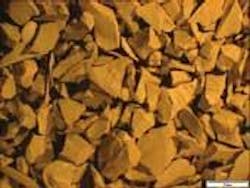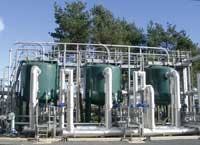Treatment System Tackles Arsenic in Drinking Water
By Larry Webb
It's been almost a decade since the US Environmental Protection Agency recommended lowering the arsenic maximum contaminant level (MCL) in drinking water from the 50 parts per billion (ppb) standard based on the suspicion of arsenic causing dangerous health effects.
Although it took until 2001 for EPA to settle on the final maximum standard of 10 ppb, the discussion surrounding the revision peaked interest among many water systems. Western parts of the United States and parts of the Midwest and New England show the higher arsenic levels in the country, but arsenic contamination is a problem that affects communities in all regions of the country.
"Hot spots" show levels considerably higher than the recently approved 10 ppb standard. Roughly 13 million Americans obtain their drinking water from public water systems that exceed the new maximum contaminant level of 10 ppb. These water systems must comply with the regulation by January 2006.
One such "hot spot" is in the City of Rio Rancho, NM. The city, which lies north of Albuquerque, first realized its arsenic problems when 13 wells within the system were identified as containing arsenic levels exceeding the 10 ppb MCL. Arsenic concentrations in these wells ranged from 11-49 ppb with accompanying flow rates of 550-2,800 gpm, totaling 23.7 mgd. The city decided against installing a centralized treatment system, and began examining technologies that could be installed at the wellhead.
The primary goal of the Rio Rancho Arsenic Program was to determine the most cost effective technology that minimized the cost to consumers. In addition, the technology installed at the wellhead would have to be a simple system that generated minimal waste, wasted minimal water, and relied on a proven technology and source of supply.
In February 2000, officials from the City of Rio Rancho attended an AWWA Inorganic Contaminant Conference in Albuquerque. At the workshop, Severn Trent Water (STW) presented a paper highlighting the results from the Severn Trent Services arsenic removal process using a granular ferric hydroxide media.
After the workshop, CH2MHill was hired to perform an engineering study to evaluate the operating and capital cost impact of installing four types of treatment systems at Rio Rancho. CH2MHill also considered other criteria in its evaluation, including waste generated, water lost and complexity of the process.
Iron adsorption was determined to offer the lowest capital cost based on the CH2MHill preliminary engineering study. Although the granular ferric hydroxide media process was simple and proven, the City of Rio Rancho needed to confirm the process economics and prove that it would be a suitable process to treat its complex New Mexico water.
Together with Severn Trent Services, Rio Rancho initiated the first pilot program for arsenic removal in New Mexico and the first U.S. pilot for the SORB 33 arsenic removal process, using a granular ferric oxide, Bayoxide E3®. The pilot was constructed and operated at a Rio Rancho well containing arsenic levels of 49 ppb, pH 8.9 and vanadium 78 ppb. Vanadium is an interferant to arsenic removal.
As the most conservative way to predict process economics during the pilot, two four inch diameter columns with five liters of Bayoxide E33 were run to arsenic exhaustion. Rio Rancho pilot results concluded that the SORB 33 process removes arsenic levels well below 10 ppb from high As and pH waters.
A pH adjustment to 6.7 is required for economical performance with the high level of vanadium present in the raw water. With an empty bed contact time of three minutes, arsenic breakthrough occurs at approximately 40,000 bed volumes. After exhaustion, the media can be sent to a non-hazardous landfill for disposal, meeting the toxic characteristics leaching procedure test.
All combined, the overall process economics have been better then predicted in the preliminary report.
Rio Rancho's plan for arsenic treatment includes minimizing costs while executing treatment technologies ahead of the 2006 schedule for compliance. The first full-scale arsenic removal system will be installed at Rio Rancho in 2003. The city will operate the first system for a full year before additional systems are considered. From 2004-2006, Rio Rancho plans to phase in the additional 12 systems requiring arsenic removal treatment, enabling the city to meet USEPA compliance by 2006.
About the Author: Larry Webb has a bachelor's degree in environmental management from University of Houston-Clear Lake. He worked for 17 years with League City, TX, as Director of Utilities. Larry has been with the City of Rio Rancho for 6 years as the director of Utilities and is currently the Past-President of the New Mexico Environmental Quality Association and Vice Chair for the NM Municipal League Domestic Well Task Force.

